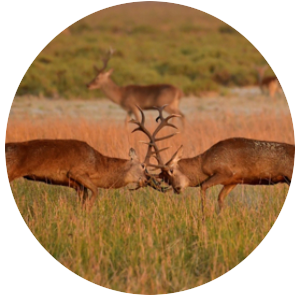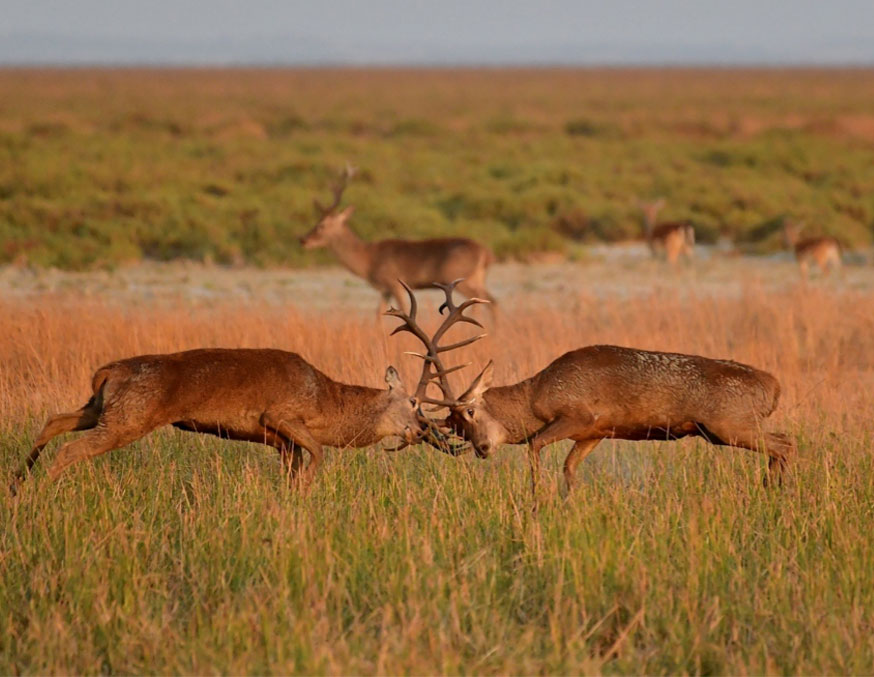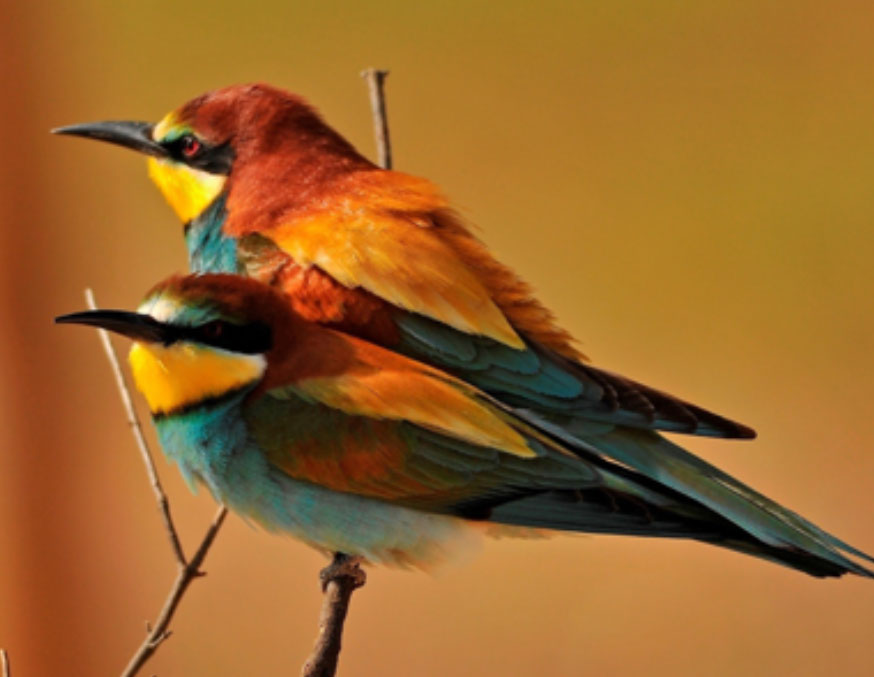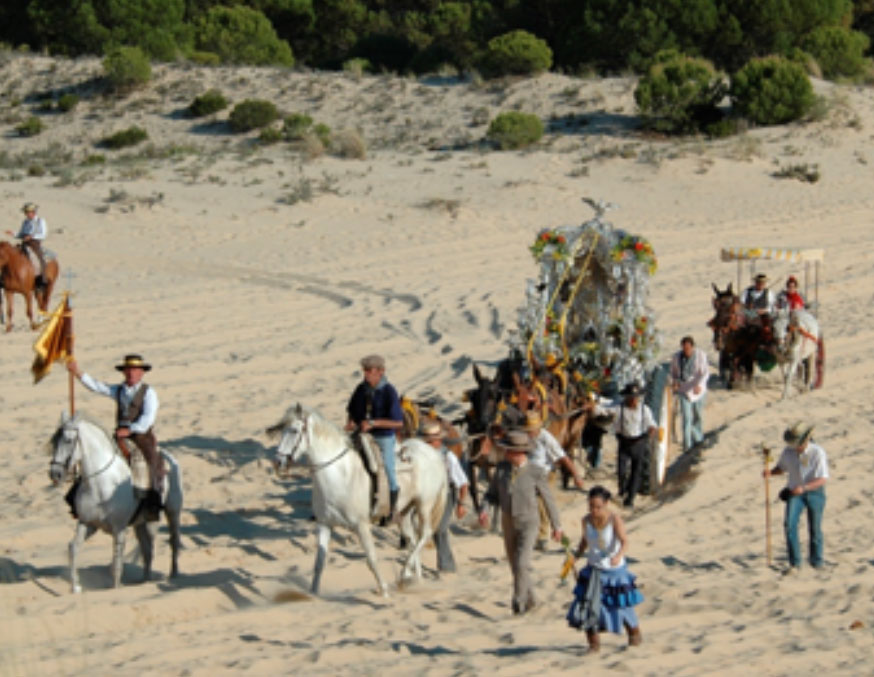

Spread over 30,000 hectares, the marshland covers almost half of Doñana National Park and is probably the ecosystem that contributes most to the uniqueness and diversity of life here and also the landscapes and colours of the park.
During the summer the marshland becomes a cracked and dusty desert. Once autumn arrives, the marshland’s channels and streams fill with water to become an immense sheet of water and then an inland sea in rainy winters. In spring there is an explosion of life in the marshland with a huge racket made by the birds and a blanket of white pondwater crowfoot flowers (Ranunculus peltatus).
The great coastal bay that existed in Roman times at the estuary of the Betis River has become a floodplain over the years as tonnes of sediment has been deposited here; it was originally dumped by the river and sea but increasingly comes from rain and the river.
It isn’t easy to spot reliefs on the huge marshland plain but, although subtle, they do exist and are extremely important. The average altitude here is around 3.6 m above sea level (very close to maximum high tide level) and the average slope is less than 0.1 0/00.
The most visible plant life species in the marshes of Doñana are the seaside bulrush (Scirpus maritimus) and saltmarsh bulrush (Scirpus littoralis) while bulrushes (Typha latifolia) and reeds (Phragmites australis) flourish in the channels and streams.
In the “high marshes”, areas that only superficially flood during rainy winters and remain dry for the rest of the year, plants that have adapted to this clay and salty steppe include: samphire (Salicornia ramosissima), seepweed (Suaeda splendens), oppositeleaved saltwork (Salsola soda) and Mediterranean bindweed (Cressa cretica).
The Doñana marshes are home to the largest number of aquatic bird species in Western Europe: practically all the European ducks, teals, shelducks, red-crested pochards, herons, spoonbills, glossy ibises, swamphens, flamingos, storks and countless waders. This has made Doñana one of the most important enclaves in Europe for the study and observation of avifauna. The marshes are also home to other species such as carp, frogs, newts, tortoises and a large number of aquatic and water-inhabiting invertebrates.
The food source of the ducks that visit Doñana. Harvesting this plant is considered a traditional use.
A plant found in watery environments that is an important component in making chairs and armchairs.
Found in Vetalengua because it can withstand salty environments such as the Lucio del Membrillo seasonal lakes.
Believed to be the original horse breed behind American horses and in towns such as Almonte and Hinojos in Doñana it features in a centuries-old tradition: La Saca de las Yeguas.
This bird thinks nothing of travelling over 400 km to come and feed in Doñana. It isn’t pink at birth but is dyed this colour by its food.
Long-legged bird with white and black feathers that has a characteristic upturned beak.
When you think of somewhere that has been made a National Park, you imagine somewhere that is a unique enclave with a grand or spectacular landscape. In terms of Doñana, the former is cer-tainly true, but you have to work a little harder to see the latter. Its flatness, aridity at certain times of year and the apparent monotony of its landscapes can make it hard to appreciate its beauty. You could say that it reveals its charms little by little, and only if you take the time to carefully unravel its mysteries and clues, slowly capturing the essence of this nature reserve and the fascinating relationship between its living inhabitants and the physical environment. This is one of Doñana’s main attractions. Let yourself be swept up by it and join the countless other travellers who have been overwhelmed by its magic and its unique and authentic beauty. Sdad. Coop. And. Marismas del Rocío “Doñana Visitas” hopes to share fundamental knowledge about the park with you so that you can appreciate its defining features.

Rutting: one of the most spectacular sights to enjoy in Doñana National Park, this natural phe-nomenon takes place from the middle to the end of August.
When the intense midday heat makes way for an evening breeze, red deer come down from dense thickets to the clearings and pastures of the vera.
Stags bellow their might to the world to draw herds of hinds to their side, jealously defending their family until spring when the hinds give birth to beautiful fawns.

Birds await the long-desired rains that flood the marshland, turn the forests green once more and sate the park’s thirst.
These birds are totally dependent on the level of flooding in this vast water plain for successful breeding; the scale of migration to Doñana is impressive and over 200,000 migratory birds pass through the zone each winter.

Geese arrive in Doñana’s marshland in winter when the cold temperatures in northern Europe freezes the fields where they feed. They are drawn to the gentle winter climate of Huelva’s wet-lands.
Geese feed on sedge roots that grow underwater in the marshes but are hard to digest. To help, the geese swallow sand before feeding; the sand works like sandpaper in their gizzard, making the roots easier to process.
And then the show begins! The break of dawn alerts the geese that it’s time to fly up to the hill that bears their name.

Spring is the moment life returns to Doñana, the days are longer, the temperatures are milder, an-imals awaken after months of lethargy, flowers inundate the landscape with brilliant colours and the sounds of nature fill the air.
In the marshes you can hear Western swamphens grunt while little grebes trill and Eurasian coots squawk in more open waters. Streaked fantail warblers circle the skies above, adding to the scene with their piercing cries.
Flamingos honk, black kites whistle and Imperial eagles give a dry bark as they soar over the pine trees.

This bird starts to appear at the end of March or the beginning of April. They visit in groups of 25-30 birds and are rarely seen travelling solo. Their unmistakeable song is instantly recognised by anyone familiar with it, alerting bird-watchers to scan the skies.
The European bee-eater is definitely one of the most eye-catching birds in these latitudes and pho-tographers and birders enjoy spotting them each year.

Each year, on the weekend of Pentecost Sunday, the village of El Rocío is visited by an immense number of pilgrims who have travelled with their brotherhood on foot, horseback or wagon to pay tribute to the Virgin of El Rocío. The celebration culminates on Sunday to Monday night, the mo-ment of “el salto a la reja” when the procession of the Virgin begins.
El Rocío is the most famous jewel of Doñana, a village with the air of an old settlement by the sea where the waters of the marshlands slowly pool.

This tradition can be traced back to an order issued in 1504 by the Duke of Medina Sidonia and the Asociación Nacional de Criadores de Ganado Marismeño has preserved it until the present day.
La Saca de las Yeguas is, broadly speaking, a farming activity that involves bringing in the marismeño horses that have spent the year grazing and breeding in different areas inside Doñana Nature Reserve and taking them to Almonte for the three-day Livestock Fair.
Once there, in the Huerta de la Cañada enclosure, yegüerizos, specialists in this breed, do the work needed to improve the well-being of these valuable animals, which are unique to the Doñana marshland ecosystem and are in danger of extinction. Once the fair has ended, the animals are returned to their environment where they remain living in freedom until the following year.
